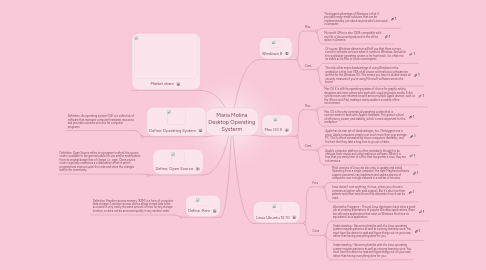
1. Define :Ram
1.1. Definition: Random-access memory (RAM) is a form of computer data storage. A random-access device allows stored data to be accessed in very nearly the same amount of time for any storage location, so data can be accessed quickly in any random order.
2. Define: Open Source
2.1. Definition: Open Source refers to a program in which the source code is available to the general public for use and/or modification from its original design free of charge, i.e., open. Open source code is typically created as a collaborative effort in which programmers improve upon the code and share the changes within the community
3. Define: Operating System
3.1. Definition: An operating system (OS) is a collection of software that manages computer hardware resources and provides common services for computer programs.
4. Market share
5. Mac OS X
5.1. Pros
5.1.1. Mac OS X is still the operating system of choice for graphic artists, designers and most others who work with visual and audio media. It also synchronizes user information well across multiple Apple devices, such as the iPhone and iPad, making it easily usable in a mobile office environment.
5.1.2. Mac OS is the only commercial operating system that is custom-made to work with Apple’s hardware. This gives it a level of efficiency, power, and stability, which is most important for the workplace.
5.2. Cons
5.2.1. Apple has its own set of disadvantages, too. The biggest one is price: Apple computers simply cost much more than your average PC. This is offset somewhat by those computers’ durability, and the fact that they take a long time to go out of date.
5.2.2. Apple’s computer platform is often mistakenly thought to be immune from viruses and other malicious software. While it is true that you rarely hear of a Mac that has gotten a virus, they are not immune.
6. Linux Ubuntu 12.10
6.1. Pros
6.1.1. Most versions of Linux are also easy to update and install. Operating from a single computer, the right Maryland software support personnel can implement and update dozens of computers over a single network in a matter of minutes.
6.1.2. Linux doesn't cost anything, it's true, unless you choose a commercial option with paid support. But it's also free from patents and other restrictions that determine how it can be used.
6.2. Cons
6.2.1. Alternative Programs – Though Linux developers have done a great job at creating alternatives to popular Windows applications, there are still some applications that exist on Windows that have no equivalent Linux application.
6.2.2. Understanding – Becoming familiar with the Linux operating system requires patience as well as a strong learning curve. You must have the desire to read and figure things out on your own, rather than having everything done for you.
6.2.3. Understanding – Becoming familiar with the Linux operating system requires patience as well as a strong learning curve. You must have the desire to read and figure things out on your own, rather than having everything done for you.
7. Windows 8
7.1. Pros
7.1.1. The biggest advantage of Windows is that it provides ready-made solutions that can be implemented by just about anyone who’s ever used a computer.
7.1.2. Microsoft Office is also 100% compatible with any file or document produced in the office space in America.
7.2. Cons
7.2.1. Of course, Windows detractors will tell you that there is more need for software services when it comes to Windows. And while this worldwide operating system is far from trash, it is often not as stable as its Mac or Linux counterparts.
7.2.2. The only other major disadvantage of using Windows in the workplace is that over 95% of all viruses and malicious software are written for the Windows OS. This means you have to double-down all security measures if you’re using Microsoft software across the board.
